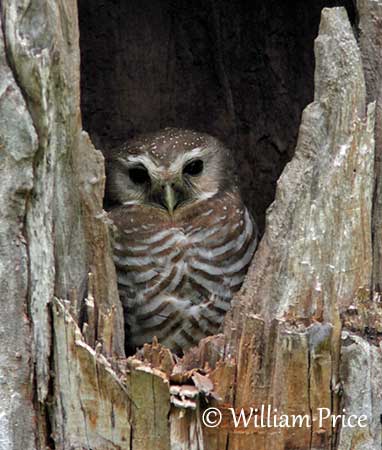
Fr: Ninoxe à sourcils blancs
Ang: White-browed Hawk-Owl
All: Madagaskarkauz
Esp: Mochuelo malgache
Ita: Gufastore cigliabianche
Nd: Madagaskarvalkuil
Sd: madagaskaruggla
Malagasy: Tovotovoka, Vorondolo
Photographers:
John Anderson
John Anderson Photo Galleries
William Price
PBase-tereksandpiper & Flickr William Price
Philip Stapelberg
GALLERY
Alan & Ann Tate
AA Bird Photography
Text by Nicole Bouglouan
Sources:
HANDBOOK OF THE BIRDS OF THE WORLD Vol 5 by Josep del Hoyo-Andrew Elliott-Jordi Sargatal - Lynx Edicions - ISBN: 8487334253
OWLS OF THE WORLD – By Claus König, Friedhelm Weick and Jan-Hendrik Becking - IBSN 978-0-7136-6548-2
Wikipedia, the free encyclopaedia
White-browed Hawk-Owl
Ninox superciliaris
Strigiformes Order – Strigidae Family
INTRODUCTION:
The White-browed Hawk-Owl is endemic to Madagascar where it is year-round resident in the drier forests and gallery forests of S and W, and mainly in lowlands.
Its rounded head lacks the typical ear-tufts, but the conspicuous white eyebrows give the bird its name.
From recent genetic data, this species could be moved to the genus Athene, but it is currently in the genus Ninox.
The White-browed Hawk-Owl is fairly common, but it depends on forested habitats. It is vulnerable to degradation of this habitat through logging. But currently, the species is not globally threatened.

DESCRIPTION OF THE BIRD:
Biometrics:
Length: 23-30 cm
Weight: 235 g
The White-browed Hawk-Owl has brown upperparts with sparse white speckles, especially on wing-coverts.
The whitish underparts are regularly barred brown, but underwing, central lower belly and undertail-coverts are plain creamy-white. The tail is uniformly brown.
The large rounded head is brownish with grey-brown facial disk and conspicuous white eyebrows. The chin is buff.
The bill is horn-coloured with pale yellowish-brown cere. It is surrounded by numerous rictal bristles. The eyes are dark brown. Bare legs and feet are pale yellow.
The White-browed Hawk-Owl is the only Ninox species with brown eyes instead of yellow. However, very old birds might have yellow to pale yellow eyes, but confirmation is required.
Male and female are similar.

BEHAVIOUR IN THE WILD:
The White-browed Hawk-Owl feeds mainly on insects and on small vertebrates such as amphibians, reptiles, chameleons, small birds, rodents (mice) and bats.
It has strictly nocturnal habits. It hunts from perch by overlooking an open area and watching for prey. Once the victim is detected and located, the owl catches it by downward swoop. However, flying insects and bats can be caught in flight too.

During the breeding season, the White-browed Hawk-Owl becomes territorial and the male gives advertising calls and songs in order to claim its territory.
The breeding behaviour is poorly known.
The White-browed Hawk-Owl is resident, with only some dispersion by immatures to N Madagascar.
This species has rather long, pointed wings, allowing agile flight. Like all Strigidae species, the flight is silent.
REPRODUCTION OF THIS SPECIES:
The breeding season occurs from October to December.
The White-browed Hawk-Owl typically nests in tree hole, usually within the forest or at the edge.
The female lays 3-5 shiny white eggs. No more information.

The juvenile resembles adults, but it has slightly narrower bars on the underparts. The tail feathers are barred brownish and white, and show narrow whitish tips. The primaries have whitish fringe at tip.
RANGE:
The White-browed Hawk-Owl occurs in Madagascar, except on central plateau.
HABITAT:
The White-browed Hawk-Owl frequents a variety of forested habitats such as evergreen humid forest, gallery forest, clearings, dry deciduous forest, open areas with semi-arid thorn scrub and few trees, rocky ravines and surroundings of villages.
The species is visible from sea-level up to 800 metres of elevation.
CALLS AND SONGS: SOUNDS BY XENO-CANTO
The White-browed Hawk-Owl is very vocal at night. The song is a howling “wuhuoh” uttered at intervals. The first notes can be hoarse “chruwuoh”.
It also produces series of several loud yelping “kwang” or “kiang” notes that rise in volume and pitch.

